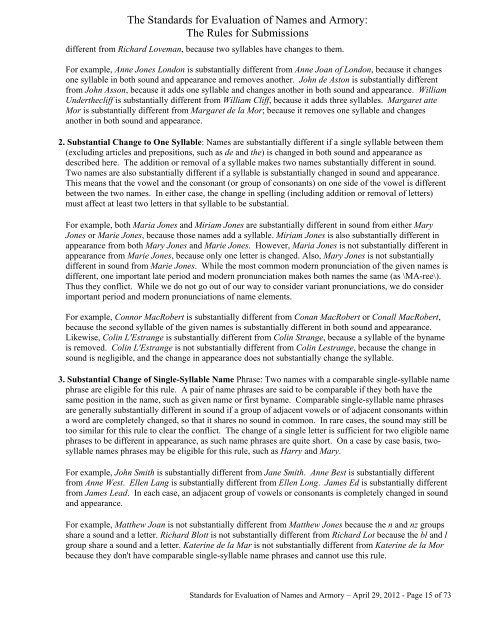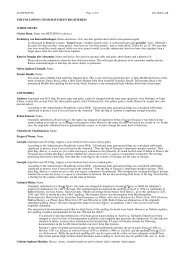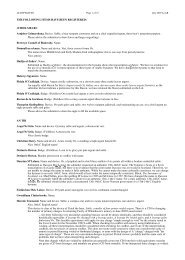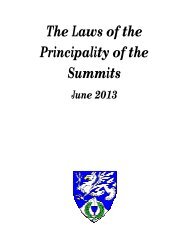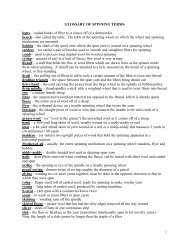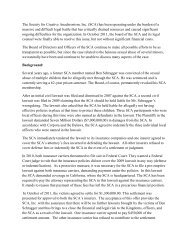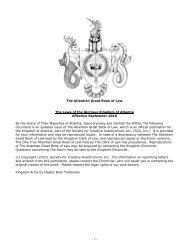The Standards for Evaluation of Names and Armory - SCA Heraldry
The Standards for Evaluation of Names and Armory - SCA Heraldry
The Standards for Evaluation of Names and Armory - SCA Heraldry
You also want an ePaper? Increase the reach of your titles
YUMPU automatically turns print PDFs into web optimized ePapers that Google loves.
<strong>The</strong> <strong>St<strong>and</strong>ards</strong> <strong>for</strong> <strong>Evaluation</strong> <strong>of</strong> <strong>Names</strong> <strong>and</strong> <strong>Armory</strong>:<strong>The</strong> Rules <strong>for</strong> Submissionsdifferent from Richard Loveman, because two syllables have changes to them.For example, Anne Jones London is substantially different from Anne Joan <strong>of</strong> London, because it changesone syllable in both sound <strong>and</strong> appearance <strong>and</strong> removes another. John de Aston is substantially differentfrom John Asson, because it adds one syllable <strong>and</strong> changes another in both sound <strong>and</strong> appearance. WilliamUnderthecliff is substantially different from William Cliff, because it adds three syllables. Margaret atteMor is substantially different from Margaret de la Mor; because it removes one syllable <strong>and</strong> changesanother in both sound <strong>and</strong> appearance.2. Substantial Change to One Syllable: <strong>Names</strong> are substantially different if a single syllable between them(excluding articles <strong>and</strong> prepositions, such as de <strong>and</strong> the) is changed in both sound <strong>and</strong> appearance asdescribed here. <strong>The</strong> addition or removal <strong>of</strong> a syllable makes two names substantially different in sound.Two names are also substantially different if a syllable is substantially changed in sound <strong>and</strong> appearance.This means that the vowel <strong>and</strong> the consonant (or group <strong>of</strong> consonants) on one side <strong>of</strong> the vowel is differentbetween the two names. In either case, the change in spelling (including addition or removal <strong>of</strong> letters)must affect at least two letters in that syllable to be substantial.For example, both Maria Jones <strong>and</strong> Miriam Jones are substantially different in sound from either MaryJones or Marie Jones, because those names add a syllable. Miriam Jones is also substantially different inappearance from both Mary Jones <strong>and</strong> Marie Jones. However, Maria Jones is not substantially different inappearance from Marie Jones, because only one letter is changed. Also, Mary Jones is not substantiallydifferent in sound from Marie Jones. While the most common modern pronunciation <strong>of</strong> the given names isdifferent, one important late period <strong>and</strong> modern pronunciation makes both names the same (as \MA-ree\).Thus they conflict. While we do not go out <strong>of</strong> our way to consider variant pronunciations, we do considerimportant period <strong>and</strong> modern pronunciations <strong>of</strong> name elements.For example, Connor MacRobert is substantially different from Conan MacRobert or Conall MacRobert,because the second syllable <strong>of</strong> the given names is substantially different in both sound <strong>and</strong> appearance.Likewise, Colin L'Estrange is substantially different from Colin Strange, because a syllable <strong>of</strong> the bynameis removed. Colin L'Estrange is not substantially different from Colin Lestrange, because the change insound is negligible, <strong>and</strong> the change in appearance does not substantially change the syllable.3. Substantial Change <strong>of</strong> Single-Syllable Name Phrase: Two names with a comparable single-syllable namephrase are eligible <strong>for</strong> this rule. A pair <strong>of</strong> name phrases are said to be comparable if they both have thesame position in the name, such as given name or first byname. Comparable single-syllable name phrasesare generally substantially different in sound if a group <strong>of</strong> adjacent vowels or <strong>of</strong> adjacent consonants withina word are completely changed, so that it shares no sound in common. In rare cases, the sound may still betoo similar <strong>for</strong> this rule to clear the conflict. <strong>The</strong> change <strong>of</strong> a single letter is sufficient <strong>for</strong> two eligible namephrases to be different in appearance, as such name phrases are quite short. On a case by case basis, twosyllablenames phrases may be eligible <strong>for</strong> this rule, such as Harry <strong>and</strong> Mary.For example, John Smith is substantially different from Jane Smith. Anne Best is substantially differentfrom Anne West. Ellen Lang is substantially different from Ellen Long. James Ed is substantially differentfrom James Lead. In each case, an adjacent group <strong>of</strong> vowels or consonants is completely changed in sound<strong>and</strong> appearance.For example, Matthew Joan is not substantially different from Matthew Jones because the n <strong>and</strong> nz groupsshare a sound <strong>and</strong> a letter. Richard Blott is not substantially different from Richard Lot because the bl <strong>and</strong> lgroup share a sound <strong>and</strong> a letter. Katerine de la Mar is not substantially different from Katerine de la Morbecause they don't have comparable single-syllable name phrases <strong>and</strong> cannot use this rule.<strong>St<strong>and</strong>ards</strong> <strong>for</strong> <strong>Evaluation</strong> <strong>of</strong> <strong>Names</strong> <strong>and</strong> <strong>Armory</strong> – April 29, 2012 - Page 15 <strong>of</strong> 73


